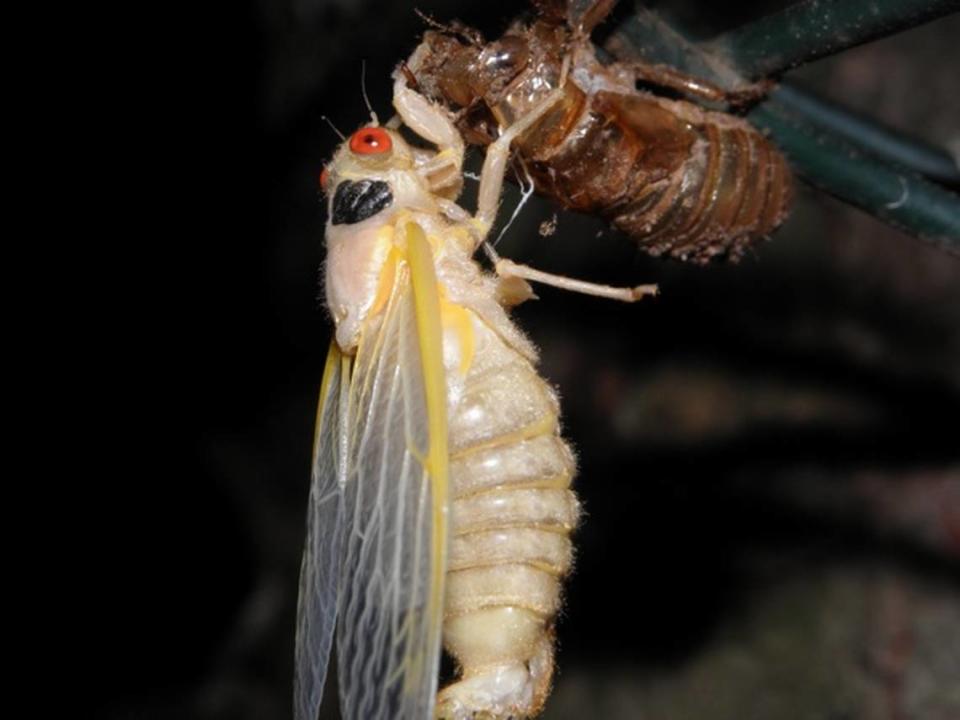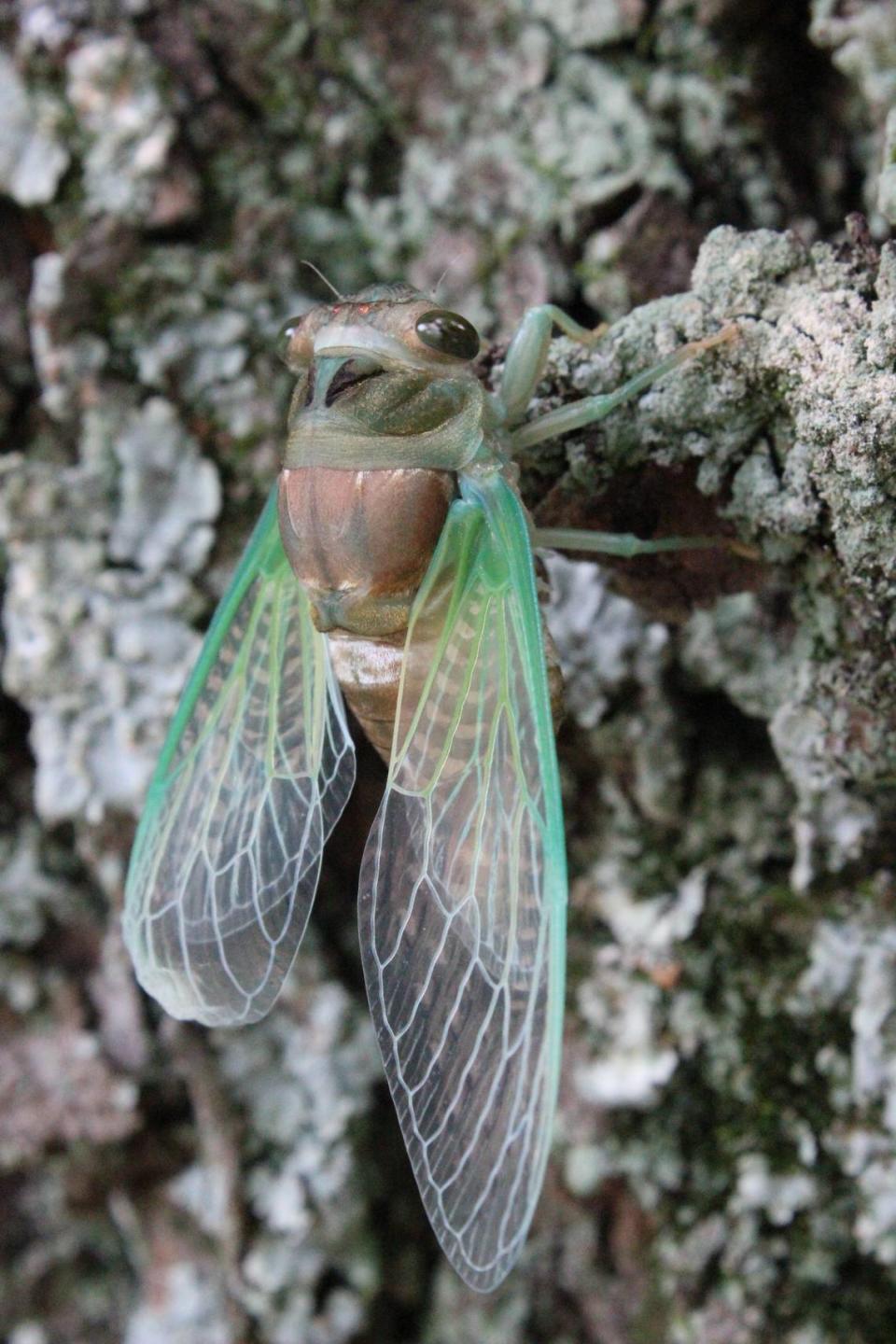Swarms of screaming insects to invade the Midwest, South soon — including parts of KY
Technically, they’re already here just below your feet, waiting for the right time to make their move.
For the first time since 1803 — the year the U.S. acquired the Louisiana Purchase from Napoleon Bonaparte — two cicada broods will co-emerge from underground. Up to a trillion of the bugs are expected to dig their way to the surface to shed their skins, find a mate if they can and then die off en masse.
Kentuckians who detest these noisy creatures can take some solace in that the two broods aren’t expected outside of a handful of counties in the western half of the state.
Well, sort of.
“Sometimes cicadas miscount and so they can come out a year early,” University of Kentucky entomologist Jonathan Larson said.
Larson was referring to cicada brood 14, which is expected to emerge across almost all of Kentucky in 2025. According to Larson, while we shouldn’t expect cicadas from broods 13 or 19 to show up in Central Kentucky, it’s possible we could see some brood 14 early risers around Frankfort, Louisville or Lexington this spring.
If you do get to experience the phenomenon this spring, whether you’re in Kentucky or not, Larson believes you should look at it as a rare opportunity to be awed by one of nature’s wonders. Thirteen-year and 17-year periodical cicadas are unique to North America, so you won’t get to see this type of event anywhere else.
“It’s almost like an alarm that reminds you that nature is still out there alive and doing stuff that you can’t have all control over,” Larson said. “I think it helps put perspective on thinking about the natural world, and it really is kind of beautiful and weird and wonderful. I just hope people will give it a shot and perform some cicada tourism. Maybe go out to Western Kentucky and take a gander.”
Here’s what to know about this fascinating event, including how you can help researchers better understand cicadas through a citizen science project.
Where will the cicadas come out in the US this year?
The two broods will emerge in states across the Southeast and Midwest, between Virginia and Illinois.
Kentucky will only see members of brood 19 emerge, and even then only in a few Western Kentucky counties. According to Larson, the confirmed counties are Allen, Caldwell, Christian and Trigg.
In 2025, brood 14 is expected to cut a swath across the commonwealth, stretching from the Bowling Green area in South-Central Kentucky all the way to the eastern half of the state.
When will the cicadas emerge in 2024?
The two broods are expected to erupt from the ground starting in late April through May and June.
According to Larson, they’ll typically wait until ground temperatures are warm enough, when it reaches 64 degrees Fahrenheit.
This roughly coincides with the first blooms of irises, Larson said. So, if you see irises in bloom around your neighborhood, you can bet the cicadas are close to emerging.
What will they do once they surface?
According to Larson, a cicada’s first impulse after surfacing from underground is to get as vertical as possible, whether that means climbing a tree, a fence or really anything that gets them off the ground.
Cicadas then shed their final adolescent exoskeleton, usually at night when they feel less vulnerable to predators who see them as a tasty “protein pack,” Larson said. They emerge in their winged form, white and soft.

Despite the radical transformation they’ve undergone and the journey they’ve taken, the cicadas can only rest until dawn. Their adult lives are short, and they have important work to do.
At this point, the males will start to sing in hopes of attracting females to mate with. First, they take to the trees and start forming little cicada fraternities by calling to other males.
“We call that calling. They’re calling and saying, ‘Hey bros, this is the best tree. Come on over. We’ll start a band.’ And then they chorus and they sing together” to call the females, Larson said.

It’s the loudest singing you’re likely to hear from a cicada, one Larson compares to the sound of an airplane. To a female cicada, this sounds like a serenade. If a female cicada accepts the advances, she will simply click her wings. She cannot sing.
Afterwards, the male cicada dies and the female flies off to lay her eggs in the cracks or holes of a tree. Then, she too dies. In several weeks, her babies will hatch, drop to the ground and frantically dig to evade predators. You won’t see them again for many years.
“They don’t do a lot of feeding when they’re adults. They don’t do much of anything, besides either trying to not get eaten by things or finding one another and mating,” Larson said.
How do cicadas know when it’s time to come out?
Cicadas track the passage of time by monitoring the ebb and flow of their food source as nymphs, Larson said.
When they’re immature, cicadas feed on the sap from the roots of trees. That sap waxes and wanes with the passing of the seasons. While they don’t exactly keep count, when 13 or 17 seasonal cycles are complete, that’s their signal to emerge, Larson said.
You may be wondering why they only do this every 13 or 17 years. According to Larson, that’s part of their survival strategy.
Few organisms, whether they’re a predator or a parasite, can adapt to feed on something that only emerges every 13 or 17 years. Not that a clumsy, defenseless cicada is difficult prey.
When the cicadas do emerge by the billions, it’s a free for all, but that’s also a survival tactic. Eventually, the predators that snap the first ones up become overwhelmed and get sick of eating the bugs.
“They’ve had too many cicadas. They don’t want to eat another one. If they never see another cicada again, it’ll be too soon. And so they’ll stop eating them. And then the ones that come out later in May and then in June, they have a higher probability of surviving to mate and produce the next generation,” Larson said.
This survival strategy is called predator satiation. When prey briefly appears in such high population densities, it reduces the likelihood of an individual being eaten.
Did you know you can eat cicadas?
According to Larson, they’re tasty. Having tasted them himself, he describes them as having a nutty flavor profile when eaten on their own.
“A lot of people will prepare them in various dishes. There’s several recipes out there, some for like frying them in a wok, putting them in rice,” Larson said.
Larson has had cicadas a few times, one of which took place at Woodford Reserve’s distillery, where he sipped bourbon and munched on cicadas prepared by a chef.
“I’ve had them mixed with tuna and rice, that was pretty tasty. And then another time I had them, they were glazed in this kind of mulberry glaze. So they were candied almost and that was really tasty as well,” Larson said.
Larson advises against consuming cicadas in bulk, given that anything from underground and of dubious origins could have its share of pollutants. So if you are curious, indulge in moderation.
How can I help scientists study them?
One citizen science project Kentuckians can contribute to is Cicada Safari.
If you can expect cicadas in your area of Kentucky, whether it’s this year or next, consider downloading the project’s mobile app. If you find a cicada, snap a photo and submit it through the app.
Once your photo is verified, it will be added to a live map.
Do you have a question about the environment in Kentucky for our service journalism team? Send us an email at ask@herald-leader.com or connect with us via the Know Your Kentucky form below.


